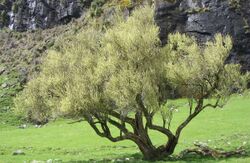Biology:Stathmopoda campylocha
| Stathmopoda campylocha | |
|---|---|

| |
| Scientific classification | |
| Domain: | Eukaryota |
| Kingdom: | Animalia |
| Phylum: | Arthropoda |
| Class: | Insecta |
| Order: | Lepidoptera |
| Family: | Stathmopodidae |
| Genus: | Stathmopoda |
| Species: | S. campylocha
|
| Binomial name | |
| Stathmopoda campylocha Meyrick, 1889[2]
| |
Stathmopoda campylocha is a species of moth in the family Stathmopodidae. It is endemic to New Zealand. It is classified as critically endangered by the Department of Conservation.
Taxonomy
This species was first described by Edward Meyrick in 1889 using specimens collected in Wellington and Dunedin in January.[3][4] The type specimen is held at the Natural History Museum, London and the type locality is recorded as being "Dunedin, New Zealand".[3]
Description
Meyrick described the species as follows:
12-14mm. Head and thorax whitish-ochreous, somewhat metallic-shining. Palpi and antennae pale whitish-ochreous. Abdomen grey. Legs whitish-ochreous, greyish-tinged, anterior pair dark grey, posterior tibiae with dark-grey scales at origin of spurs. Forewings elongate, very narrow, broadest near base, long-pointed ; whitish-ochreous ; an ochreous-fuscous or dark fuscous streak along costa from base to 3⁄4, sometimes almost obsolete ; an ochreous-fuscous or dark fuscous broadly V-shaped mark before middle, more or less suffused, variable in thickness, its angle resting on inner margin, extremities nearly reaching costa ; a longitudinal line in posterior half of disc, a spot at apex, and an elongate spot at anal angle ochreous-fuscous or ochreous, sometimes partially connected : cilia grey. Hindwings rather dark grey ; cilia grey.[4]
Distribution
This species is endemic to New Zealand.[2][5] Historically this species occurred at Wellington and Dunedin,[6] and in 1915 Charles E. Clarke collected a specimen in mid December at Silverstream, Upper Hutt.[7] A further specimen was collected in early February in 1932 in the Pohangina Forest Reserve and was used by George Vernon Hudson to create an illustration of the species.[8] In more recent times S. campylocha has been found to be present in western and eastern Otago including in the Matukituki Valley.[9][10]
Ecology and habitat
Meyrick collected his specimens amongst forest[4] and Hudson concurred that the species frequents forest habitat.[6]
Host species
In 2000 Brian H. Patrick discovered that S. campylocha is associated with the nationally endangered plant Olearia hectorii.[9][10] Patrick was unable to locate S. campylocho larvae feeding but he hypothesised that they are likely detritivores or alternatively that they feed on scale insects.[9] He also suggested other possible host plants might be Olearia fimbriata, Olearia lineata, Olearia bullata or Olearia fragrantissima.[9] Plant-SyNZ indicates Olearia virgata as another possible host plant, attributed to Patrick (2000).
Conservation status
In 1939 Hudson stated that S. campylocha was regarded as being extremely rare.[8] This species has been given the "Nationally Critical" conservation status under the New Zealand Threat Classification System.[1]
References
- ↑ 1.0 1.1 Hoare, R.J.B.; Dugdale, J.S.; Edwards, E.D.; Gibbs, G.W.; Patrick, B.H.; Hitchmough, R.A.; Rolfe, J.R. (2017). "Conservation status of New Zealand butterflies and moths (Lepidoptera), 2015". New Zealand Threat Classification Series 20: 6. http://www.doc.govt.nz/Documents/science-and-technical/nztcs20entire.pdf.
- ↑ 2.0 2.1 "Stathmopoda campylocha Meyrick, 1889". Landcare Research New Zealand Ltd. http://www.nzor.org.nz/names/50d5e652-b5c3-4681-ab24-5929601e7db8.
- ↑ 3.0 3.1 Dugdale, J. S. (1988). "Lepidoptera - annotated catalogue, and keys to family-group taxa". Fauna of New Zealand 14: 108. https://www.landcareresearch.co.nz/__data/assets/pdf_file/0017/26324/FNZ14Dugdale1988.pdf. Retrieved 1 May 2018.
- ↑ 4.0 4.1 4.2 Meyrick, Edward (1889). "Descriptions of New Zealand Micro-lepidoptera.". Transactions and Proceedings of the New Zealand Institute 21: 154–188. https://biodiversitylibrary.org/page/3290252. Retrieved 1 May 2018.
- ↑ , p. 463, Wikidata Q45922947
- ↑ 6.0 6.1 Hudson, G. V. (1928). The Butterflies and Moths of New Zealand. Wellington: Ferguson & Osborn Ltd.. pp. 299. http://www.bugz.org.nz/WebForms/ResultDetails.aspx?CurrentDoc=C7E94865-492F-45DA-9777-CC8E1E8B1438&back=true&NewDoc=true&searchType=1&SearchString=G.V.+Hudson.
- ↑ "Stathmopoda campylocha". Auckland War Memorial Museum. http://www.aucklandmuseum.com/collections-research/collections/record/am_naturalsciences-object-135809.
- ↑ 8.0 8.1 Hudson, George Vernon (1939). A supplement to the butterflies and moths of New Zealand.. Wellington: Ferguson & Osborn Ltd.. pp. 456. http://www.bugz.org.nz/WebForms/ResultDetails.aspx?CurrentDoc=4A102474-EF01-4089-A31A-A1FE7E551E52&back=true&NewDoc=true&searchType=1&SearchString=Hudson.
- ↑ 9.0 9.1 9.2 9.3 Patrick, Brian (2000). "Lepidoptera of small-leaved divaricating Olearia in New Zealand and their conservation priority.". Science for Conservation (New Zealand Department of Conservation) 168: 1–26. ISSN 1173-2946. OCLC 48661253. http://nationalparks.co.nz/Documents/science-and-technical/Sfc168.pdf. Retrieved 1 May 2018.
- ↑ 10.0 10.1 Mt Aspiring Station Conservation Resources Report Part 1 (Report). Department of Conservation. November 2005. pp. 1–62. http://www.linz.govt.nz/crown-property/crown-pastoral-land/status-and-location-crown-pastoral-land/mt-aspiring-station. Retrieved 2 May 2018.
External links
Wikidata ☰ Q14382651 entry
 |



